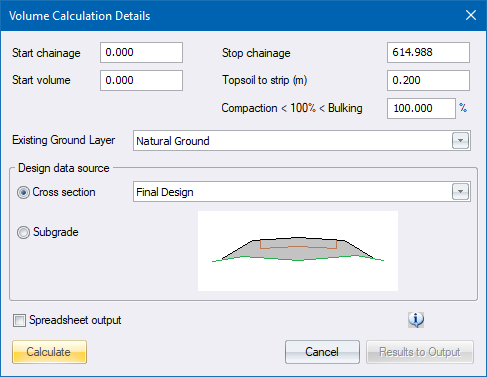

Specify the parameters for the volume calculations.
|
Option
|
Description |
|
Start chainage |
Enter the first chainage of the range of chainages for which volumes should be calculated. |
|
Stop chainage |
Enter the last chainage of the range of chainages for which volumes should be calculated. |
|
Start volume |
Enter the volume that should be added to the overall run to accommodate arbitary items such as borrow material, bellmouths, culverts, etc. |
|
Topsoil to strip (m) |
Enter the depth of topsoil that should be stripped from cross-sections before volumes are calculated. |
|
Compaction < 100% < Bulking |
Enter the bulking or compaction factor that should be applied to calculated cut volumes. Factors of over 100 imply bulking while factors under 100 imply compaction. A value of 100 will ignore any form of bulking or compaction. |
|
Existing Ground Layer |
Select the existing ground layer for volume calculations. |
| Design data source | |
| Cross-Section | Select the batter layer for which volumes should be calculated. |
| Subgrade | Select this checkbox if you want the volume to be between the existing ground and the subgrade layer - below the template defined layerworks. |
|
Spreadsheet output |
Select this checkbox to have the results of this function written out in comma-delimited format suitable for importing into a spreadsheet. |
|
Calculate button |
Calculate the volumes. This allows you to set different topsoil stripping and compaction/bulking factors before printing the results. |
|
Results to Output button |
Click to print the final result of the volume calculation. This button is activated after volumes for the first defined range have been calculated. |
See Volume calculations for an explanation of the output.
See Also Masshaul Volumes, Cumulative Volumes